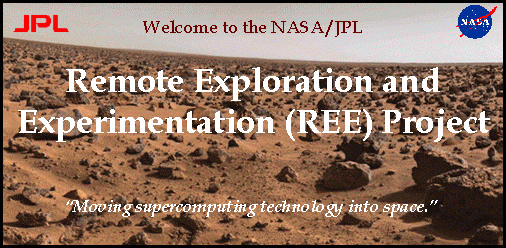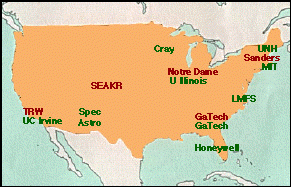

Objectives: The objective of the REE Study Phase is to team with industry and academia to assess via analysis and simulation the feasibility of and trade-offs involved in developing a low-power, fault-tolerant, scalable, high-performance architecture for spaceborne computing.
Approach: Solicit participation in the REE Study Phase by teams to study architectural specifications, dense packaging options, technology projections, system software approaches, software development strategies, and performance metrics. At the completion of the study phase, the teams will report on trade-offs and feasibility, including considerations of absolute performance (MIPS), normalized performance (MIPS/watt), scalability, reliability, fault-tolerance, risk, and cost. Each study team will prepare and submit a final report summarizing the results of their study and presenting an implementation plan for developing the proposed architecture. The Study Phase will last six months.
Accomplishments: A RFP was issued in March 1996 soliciting participation in the REE Study Phase. Ten proposals were received in response to this RFP. Five were selected for funding. The organizations leading the five winning teams are: Georgia Institute of Technology; Sanders, a Lockheed Martin Company; SEAKR Engineering, Inc.; TRW, Inc.; and the University of Notre Dame. Nine other organizations are participating in this study as members of the five teams. The names and locations of these fourteen organizations are noted in the figure below. The proposal teams formally began work May 15, 1996.

Five teams, involving fourteen organizations, began
work on the six-month REE Study Phase in May 1996.
Lead organizations are shown in red.
Significance: The REE Study Phase is a vital part of this planning process in several respects. First, the study phase results will be used to develop the REE Project Plan. This plan will describe project tasks, deliverables, and costs through 2003. Second, the study phase will set the stage for the formation of long-term partnerships with industry, since most of the study team participants are potential collaborators in the future development of hardware prototypes. Third, it is a highly cost-effective way of gathering information. For a relative modest investment ($450K), the REE Project will acquire the equivalent of many millions of dollars worth of industrial R&D knowledge, leveraging work sponsored by other government agencies, such as DARPA and BMDO. But in a broader sense, the study phase is significant in that it is the first step on a new pathway, one that is not currently being pursued. This is the pathway leading to scalable computing in space. The study phase will help us map out this path, ultimately leading to the demonstration that a new class of science can be enabled by on-board scalable computing.
Status/Plans: The REE Study Phase is nearing its end. Draft final report reviews will be held at JPL in late October 1996. Final Reports will be delivered to JPL by November 15, 1996. The results presented in these reports will constitute a primary input to be used in the development of the REE Project Plan. Draft versions of the Project Plan will be available for circulation in January 1997. Upon acceptance of the Project Plan, partnerships with industry, academia, and the space and Earth science community will be established to prototype hardware, system software, and science applications which can eventually be demonstrated in space. This demonstration could take place as early as 2001.
Point of Contact:
Dr. Robert Ferraro
Jet Propulsion Laboratory
ferraro@zion.jpl.nasa.gov
818-354-1340
URL: http://www-ree.jpl.nasa.gov